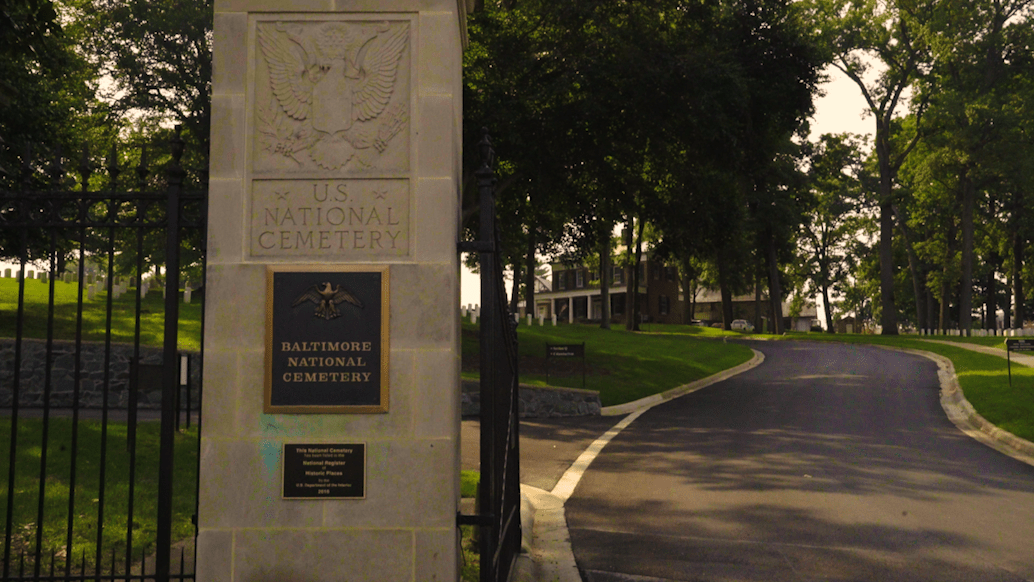59 of our national cemeteries have lodges on property. In most cases, they are used as administration buildings or by Veteran Service Organizations. In five cases, like Baltimore National Cemetery, the lodge is used as a full time residence for cemetery directors.
One of the best views
Graham Wright has one of the best views in the entire National Cemetery Administration (NCA). When he walks out his front door, he see the history. But it’s the back-door view that is truly breathtaking.
“In front of me are the rolling hills with all of the headstones,” said Wright. “I can see San Diego Harbor to my left and the Pacific Ocean off in the distance. I could look at the ocean all day long.”
Wright, a retired U.S. Navy Veteran and a 2014 graduate of NCA’s year-long Cemetery Director course, is the Assistant Director for Fort Rosecrans and Miramar National Cemeteries in San Diego, California. He, and his family, live in the historic lodge located on Fort Rosecrans.
Wright remembers the national cemetery from when he was stationed in San Diego. “Now I have the best commute in the area,” he says. “At first, I got mixed reactions from friends and family when I told them we were going to live on the cemetery grounds,” remembered Wright. “People look at you a little strange, then when they visit, they want to live here.”
Lodges date back to the end of the Civil War
Lodges on cemetery grounds date back to immediately after the end of the Civil War when national cemeteries were being built around the country to provide a final resting place of dignity, honor, and respect for the fallen. The initial period of temporary frame lodge construction went from 1867 to 1869 and overlapped with the construction of the first permanent masonry lodges. A one-and-one-half-story, L-plan house with mansard roof in the Second Empire style—was refined over a two-year period before civil engineer Thomas P. Chiffelle drew a definitive version of it in 1871. The first of this style is at Richmond National Cemetery in Virginia. In the 1870s, the army built L-plan lodges with mansard roofs in dozens of national cemeteries. The design was altered in 1885-1895 before being abandoned completely.

Assistant Director Graham Wright and his family currently reside in the cemetery lodge at Fort Rosecrans National Cemetery.
From the 1920s through 1940s, lodge construction used typical suburban house forms as well as revival-style and neoclassical designs intended to match the lodges to their local settings. New lodge construction ceased around 1960. The lodge at Fort Rosecrans National Cemetery was built in 1936 and is significant as the prototype for the Southwestern Ranch style of lodge design.
In another example, the desire to match designs to localities prompted the alteration of the revised L-plan lodge built at San Francisco in 1885 into a Spanish Mission Revival building in 1929. The survival of the San Francisco lodge is especially significant because it represents the first departure from the L-plan design as the Quartermaster’s office sought to integrate the living quarters of the cemetery superintendents into the trends shaping residential architecture in the twentieth century.
Today, NCA has 55 lodges, the oldest dating back to 1870.
They get pulled by the history
Kathy McCall knows this feeling of living in an historic lodge of a VA national cemetery all too well. For the past 11 years, she has been the main lodge resident at the San Francisco National Cemetery, also known as the Presidio. A graduate of the first Cemetery Director class in 2005, she jumped at the chance to live on the cemetery grounds.
“My views are magnificent,” said McCall, who is also the Director of nearby Golden Gate National Cemetery. “Rows and rows of historic headstones and then off in the distance the spires of the Golden Gate Bridge, the bay, and Alcatraz.”
While appreciating the beautiful panoramas and landscapes, these Cemetery Directors are driven in their mission to serve Veterans, their families, and the public. Living on the cemetery grounds makes that easier to do.
“We have many visitors,” said McCall. “They appreciate the beautiful setting and get pulled by the history.”
This story was produced through the cooperative efforts of multiple VA employees. NCA would like to thank Timothy Lawson for the video production and interviews at Baltimore National Cemetery, Jim Theres for his interviews and story of the Fort Rosecrans and San Francisco National Cemeteries, Director Kathy McCall and Assistant Directors Konrad Tolai and Graham Wright for sharing their unique experiences residing in the historic cemetery lodges.
Topics in this story
More Stories
Over the five-year program, more than 14,000 VET TEC beneficiaries completed their program and nearly half have reported finding meaningful employment with an average starting annual salary of $65,000.
VA is calling for applicants for the 2024 Specially Adapted Housing Assistive Technology grant.
Updated COVID vaccines are available free of charge to Veterans receiving care at VA .









I bet it is real quiet and a low crime area?
My husband his last wish was to burry in Arligton Cemetery in Washington DC.He is a veteran of world II Corean and Vietnam.We have the day Dec.17 2018. Where do we have to stay for 3 nights
that is reasonable.Any advise appreciate.Thank you..
We take so much from our beautiful planet and give nothing back! I’m looking for a natural burial ground in my State of Delaware. I would like to be buried in a cotton shroud and contribute to replenishing this planet. It would be such an honor to maybe be responsible for nourishing an Oak Tree or even daffodils,dandelions or milkweed for the butterflies. Stones or a boulder could be utilized for my marker, tho not necessary.
Since National Cemeteries were not established until the end of the civil war it’s important to remember our patriots of the american war of revolution and 1812 are buried just about anywhere and the illegible stone for one I know of, who was at Valley Forge is in Chester County, PA.